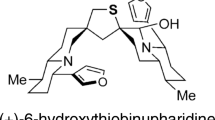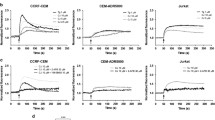Abstract
Flunarizine is a Ca2+ channel blocker that can be either cytoprotective or cytotoxic, depending on the cell type that is being examined. We show here that flunarizine was cytotoxic for Jurkat T-leukemia cells, as well as for other hematological maligancies, but not for breast or colon carcinoma cells. Treatment of Jurkat cells with flunarizine resulted in caspase-3 activation, poly (ADP-ribose) polymerase cleavage, and laddering of DNA fragments, all of which are hallmarks of apoptosis. Flunarizine-induced DNA fragmentation was inhibited by the caspase-3 inhibitor z-DEVD-fmk, the caspase-8/caspase-10 inhibitor z-IETD-fmk, and the caspase-10 inhibitor z-AEVD-fmk, but was not reduced in caspase-8-deficient Jurkat cells, indicating the involvement of caspase-10 upstream of caspase-3 activation. Interestingly, FADD recruitment to a death receptor was not involved since flunarizine caused DNA fragmentation in FADD-deficient Jurkat cells. Flunarizine treatment of Jurkat cells also resulted in reactive oxygen species production, dissipation of mitochondrial transmembrane potential, release of cytochrome c from mitochondria, and caspase-9 activation, although none of these events were necessary for apoptosis induction. Collectively, these findings indicate that flunarizine triggers apoptosis in Jurkat cells via FADD-independent activation of caspase-10. Flunarizine warrants further investigation as a potential anti-cancer agent for the treatment of hematological malignancies.











Similar content being viewed by others
References
Amery WK (1983) Flunarizine, a calcium channel blocker: a new prophylactic drug in migraine. Headache 23:70–74
Wang RF, Gagliuso DJ, Podos SM (2008) Effect of flunarizine, a calcium channel blocker, on intraocular pressure and aqueous humor dynamics in monkeys. J Glaucoma 17:73–78
Vitebskiy SA, Khrestian CM, Waldo AL (2007) Termination of a tachyarrhythmia by flunarizine is not a specific marker for a triggered mechanism. Heart Rhythm 4:1544–1552
Kaminski Schierle GS, Hansson O, Brundin P (1999) Flunarizine improves the survival of grafted dopaminergic neurons. Neuroscience 94:17–20
Schierle GS, Hansson O, Leist M, Nicotera P, Widner H, Brundin P (1999) Excitotoxicity plays a role in the death of tyrosine hydroxylase-immunopositive nigral neurons cultured in serum-free medium. Exp Neurol 157:338–348
Rich KM, Hollowell JP (1990) Flunarizine protects neurons from death after axotomy or NGF deprivation. Science 248:1419–1421
Takei M, Hiramatsu M, Mori A (1994) Inhibitory effects of calcium antagonists on mitochondrial swelling induced by lipid peroxidation or arachidonic acid in the rat brain in vitro. Neurochem Res 19:1199–1206
Gonçalves T, Carvalho AP, Oliveira CR (1991) Antioxidant effect of calcium antagonists on microsomal membranes isolated from different brain areas. Eur J Pharmacol 204:315–322
So HS, Kim HJ, Lee JH, Lee JH, Park SY, Park C, Kim YH, Kim JK, Lee KM, Kim KS, Chung SY, Jang WC, Moon SK, Chung HT, Park RK (2006) Flunarizine induces Nrf2-mediated transcriptional activation of heme oxygenase-1 in protection of auditory cells from cisplatin. Cell Death Differ 13:1763–1775
Gallego-Sandín S, Novalbos J, Rosado A, Cano-Abad MF, Arias E, Abad-Santos F, García AG (2005) Albumin prevents mitochondrial depolarization and apoptosis elicited by endoplasmic reticulum calcium depletion of neuroblastoma cells. Eur J Pharmacol 520:1–11
Barancík M, Poleková L, Mrázová T, Breier A, Stankovicová T, Slezák J (1994) Reversal effects of several Ca2+-entry blockers, neuroleptics and local anaesthetics on P-glycoprotein-mediated vincristine resistance of L1210/VCR mouse leukaemic cell line. Drugs Exp Clin Res 20:13–18
Castellino SM, Friedman HS, Elion GB, Ong ET, Marcelli SL, Page R, Bigner DD, Dewhirst MW (1995) Flunarizine enhancement of melphalan activity against drug-sensitive/resistant rhabdomyosarcoma. Br J Cancer 71:1181–1187
Gornati D, Zaffaroni N, Villa R, De Marco C, Silvestrini R (1997) Modulation of melphalan and cisplatin cytotoxicity in human ovarian cancer cells resistant to alkylating drugs. Anticancer Drugs 8:509–516
Matzinger P (1991) The JAM test. A simple assay for DNA fragmentation and cell death. J Immunol Methods 15:185–192
Zamzami N, Marchetti P, Castedo M, Zanin C, Vayssière JL, Petit PX, Kroemer G (1995) Reduction in mitochondrial potential constitutes an early irreversible step of programmed lymphocyte death in vivo. J Exp Med 181:1661–1672
Perticarari S, Presani G, Mangiarotti MA, Banfi E (1991) Simultaneous flow cytometric method to measure phagocytosis and oxidative products by neutrophils. Cytometry 12:687–693
Tewari M, Quan LT, O’Rourke K, Desnoyers S, Zeng Z, Beidler DR, Poirier GG, Salvesen GS, Dixit VM (1995) Yama/CPP32 beta, a mammalian homolog of CED-3, is a CrmA-inhibitable protease that cleaves the death substrate poly(ADP-ribose) polymerase. Cell 81:801–809
Li P, Nijhawan D, Budihardjo I, Srinivasula SM, Ahmad M, Alnemri ES, Wang X (1997) Cytochrome c and dATP-dependent formation of Apaf-1/caspase-9 complex initiates an apoptotic protease cascade. Cell 91:479–489
Bayir H, Fadeel B, Palladino MJ, Witasp E, Kurnikov IV, Tyurina YY, Tyurin VA, Amoscato AA, Jiang J, Kochanek PM, DeKosky ST, Greenberger JS, Shvedova AA, Kagan VE (2006) Apoptotic interactions of cytochrome c: redox flirting with anionic phospholipids within and outside of mitochondria. Biochim Biophys Acta 1757:648–659
Lorenzo HK, Susin SA, Penninger J, Kroemer G (1999) Apoptosis inducing factor (AIF): a phylogenetically old, caspase-independent effector of cell death. Cell Death Differ 6:516–524
Daugas E, Susin SA, Zamzami N, Ferri KF, Irinopoulou T, Larochette N, Prévost MC, Leber B, Andrews D, Penninger J, Kroemer G (2000) Mitochondrio-nuclear translocation of AIF in apoptosis and necrosis. FASEB J 14:729–739
Halestrap AP, Connern CP, Griffiths EJ, Kerr PM (1997) Cyclosporin A binding to mitochondrial cyclophilin inhibits the permeability transition pore and protects hearts from ischaemia/reperfusion injury. Mol Cell Biochem 174:167–172
Susin SA, Zamzami N, Castedo M, Hirsch T, Marchetti P, Macho A, Daugas E, Geuskens M, Kroemer G (1996) Bcl-2 inhibits the mitochondrial release of an apoptogenic protease. J Exp Med 184:1331–1341
Ryter SW, Kim HP, Hoetzel A, Park JW, Nakahira K, Wang X, Choi AM (2007) Mechanisms of cell death in oxidative stress. Antioxid Redox Signal 9:49–89
Tong WM, Cortes U, Wang ZQ (2001) Poly(ADP-ribose) polymerase: a guardian angel protecting the genome and suppressing tumorigenesis. Biochim Biophys Acta 1552:27–37
Chowdhury I, Tharakan B, Bhat GK (2006) Current concepts in apoptosis: the physiological suicide program revisited. Cell Mol Biol Lett 11:506–525
Juo P, Kuo CJ, Yuan J, Blenis J (1998) Essential requirement for caspase-8/FLICE in the initiation of the Fas-induced apoptotic cascade. Curr Biol 8:1001–1008
Ashkenazi A, Dixit VM (1998) Death receptors: signaling and modulation. Science 281:1305–1308
Cagnol S, Van Obberghen-Schilling E, Chambard JC (2006) Prolonged activation of ERK1, 2 induces FADD-independent caspase 8 activation and cell death. Apoptosis 11:337–346
Garcia-Calvo M, Peterson EP, Leiting B, Ruel R, Nicholson DW, Thornberry NA (1998) Inhibition of human caspases by peptide-based and macromolecular inhibitors. J Biol Chem 273:32608–32613
Kischkel FC, Lawrence DA, Tinel A, LeBlanc H, Virmani A, Schow P, Gazdar A, Blenis J, Arnott D, Ashkenazi A (2001) Death receptor recruitment of endogenous caspase-10 and apoptosis initiation in the absence of caspase-8. J Biol Chem 276:46639–46646
Milhas D, Cuvillier O, Therville N, Clavé P, Thomsen M, Levade T, Benoist H, Ségui B (2005) Caspase-10 triggers Bid cleavage and caspase cascade activation in FasL-induced apoptosis. J Biol Chem 280:19836–19842
Zou H, Li Y, Liu X, Wang X (1999) An APAF-1. cytochrome c multimeric complex is a functional apoptosome that activates procaspase-9. J Biol Chem 274:11549–11556
Li H, Zhu H, Xu CJ, Yuan J (1998) Cleavage of BID by caspase 8 mediates the mitochondrial damage in the Fas pathway of apoptosis. Cell 94:491–501
Mott JL, Zhang D, Chang SW, Zassenhaus HP (2006) Mitochondrial DNA mutations cause resistance to opening of the permeability transition pore. Biochim Biophys Acta 1757:596–603
Marsden VS, O’Connor L, O’Reilly LA, Silke J, Metcalf D, Ekert PG, Huang DC, Cecconi F, Kuida K, Tomaselli KJ, Roy S, Nicholson DW, Vaux DL, Bouillet P, Adams JM, Strasser A (2002) Apoptosis initiated by Bcl-2-regulated caspase activation independently of the cytochrome c/Apaf-1/caspase-9 apoptosome. Nature 419:634–637
Ott M, Gogvadze V, Orrenius S, Zhivotovsky B (2007) Mitochondria, oxidative stress and cell death. Apoptosis 12:913–922
Cai J, Jones DP (1998) Superoxide in apoptosis. Mitochondrial generation triggered by cytochrome c loss. J Biol Chem 273:11401–11404
Acknowledgments
The authors thank Julie Long for technical assistance. This research was supported by a grant to D.H. from the Natural Sciences and Engineering Research Council (NSERC). D.C. was the recipient of postgraduate scholarships from NSERC and the Nova Scotia Health Research Foundation. S.F. and C.D. are recipients of NSERC postgraduate scholarships.
Author information
Authors and Affiliations
Corresponding author
Additional information
David M. Conrad and Suzanne J. Furlong contributed equally to this work.
Rights and permissions
About this article
Cite this article
Conrad, D.M., Furlong, S.J., Doucette, C.D. et al. The Ca2+ channel blocker flunarizine induces caspase-10-dependent apoptosis in Jurkat T-leukemia cells. Apoptosis 15, 597–607 (2010). https://doi.org/10.1007/s10495-010-0454-3
Published:
Issue Date:
DOI: https://doi.org/10.1007/s10495-010-0454-3




